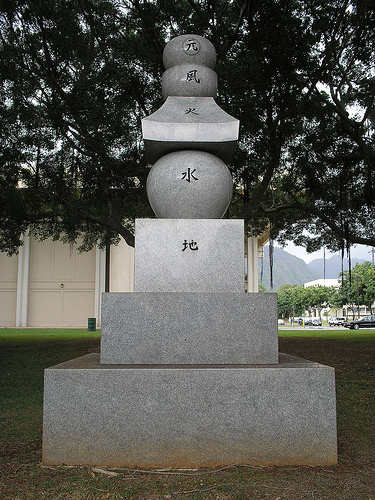|
|
|
 THE FIVE ELEMENTS
THE FIVE ELEMENTS
The five elements are, in ascending order of power,
地 ( chi or tsuchi) Earth,
水 (sui or mizu) Water,
火 (ho, ka or hi) Fire,
風 (fū or kaze) Wind,
空 (kū) Heaven,
This last is usually translated as "void" when referring to the elements, but refers to "sky" in most
other contexts, and is therefore sometimes translated as "Heaven".
Sometimes a sixth element is added, representing
Consciousness, or 識 (shiki).
Chi
地 Chi (sometimes ji) or tsuchi, meaning "Earth", represents the hard, solid objects of the world. The most basic example of chi is in a stone. Stones are highly resistant to movement or change, as is anything heavily influenced by chi. In people, the bones, muscles and tissues are represented by chi. Emotionally, chi is predominantly associated with stubbornness, stability, physicality, and gravity. In the mind, it is confidence; and emotionally it is a desire to have things remain as they are; a resistance to change. When under the influence of this chi mode or "mood", we are aware of our own physicality and sureness of action.
Sui
水 Sui or mizu, meaning "Water", represents the fluid, flowing, formless things in the world. Outside of the obvious example of rivers and the like, plants are also categorized under sui, as they adapt to their environment, growing and changing according to the direction of the sun and the changing seasons. Blood and other bodily fluids are represented by sui, as are mental or emotional tendencies towards adaptation and change. sui can be associated with emotion, defensiveness, adaptability, flexibility, suppleness, and magnetism.
Ka
火 Ka or hi, meaning "Fire", represents the energetic, forceful, moving things in the world. Animals, particularly predators, capable of movement and full of forceful energy, are primary examples of ka objects. Bodily, ka represents our metabolism and body heat, and in the mental and emotional realms, it represents drive and passion. ka can be associated with motivation, desire, intention, and an outgoing spirit. Besides the obvious examples of heat and flame, lightning can also be thought of as an extension of Ka.
Fū
風 Fū or kaze, meaning "Wind", represents things that grow, expand, and enjoy freedom of movement. Aside from air, smoke, and the like, f¨± can in some ways be best represented by the human mind. As we grow physically, we learn and expand mentally as well, in terms of our knowledge, our experiences, and our personalities. F¨± represents breathing, and the internal processes associated with respiration. Mentally and emotionally, it represents an "open-minded" attitude and carefree feeling. It can be associated with will, elusiveness, evasiveness, benevolence, compassion, and wisdom.
Kū
空 Kū or sora, most often translated as "Void", but also meaning "sky" or "Heaven", represents those things beyond our everyday experience, particularly those things composed of pure energy. Bodily, kū represents spirit, thought, and creative energy. It represents our ability to think and to communicate, as well as our creativity. It can also be associated with power, creativity, spontaneity, and inventiveness.
Kū is of particular importance as the highest of the elements. In martial arts, particularly in fictional tales where the fighting discipline is blended with magic or the occult, one often invokes the power of the Void to connect to the quintessential creative energy of the world. A warrior properly attuned to the Void can sense his surrounding and act without thinking, and without using his physical senses.
Class Schedule
Tuesday
5-6 PM-Karate
6-7 PM-Weapons
7-9 PM Tai Chi and Self-Defense
Thursday
5-6 PM-Karate
6-7 PM-Weapons
7-9 PM Tai Chi and Self-Defense
Saturday
9-10 AM Junior Black Belts
10-11 AM-Adolescent Open Session
11-12 Pm-Adult Open Session
|

